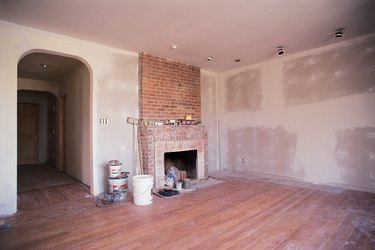Things You'll Need
Dust mask
Narrow-blade putty knife
120- or 150-grit sandpaper
Sponge
Broom
Dustpan
Latex primer
Paintbrush
Hand sander (optional)

Spackling compound allows you to fix holes in walls and prepares the walls for priming and painting. This gypsum-powder joint compound is a staple of home-improvement projects, but filling in holes with spackling and a putty knife isn't the end of the job. Spackling leaves a rough finish on walls that has to be sanded down.
Step 1
Put on a dust mask to avoid inhaling small particles.
Video of the Day
Step 2
Chip off large chunks of spackling with a small metal putty knife. Scrape the blade of the knife gently against any ridges to remove them.
Step 3
Sand the remaining spackling in a circular motion with a piece of 120- or 150-grit sandpaper. Use a hand sander to make the job go faster.
Step 4
Wipe the wall with a damp sponge to remove leftover dust. Sweep up any dust on the floor with a broom.
Step 5
Prime the spot where the spackling was with latex primer before painting over it. Paint the primer onto the spot with a bristle or sponge brush.
Tip
An electric sander with a disk can make removing spackling compound faster if there's a lot to remove. It also saves your hands and arms from soreness.
Video of the Day